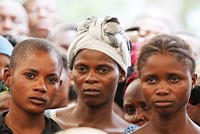Women’s human rights and gender-related concerns in situations of conflict and instability
OHCHR and women’s human rights and gender equality
Conflicts and situations of instability exacerbate pre-existing patterns of discrimination against women and girls, exposing them to heightened risks of violations of their human rights.
Heightened gender-based violence in conflict and post-conflict zones
Conflict can result in higher levels of gender-based violence against women and girls, including arbitrary killings, torture, sexual violence and forced marriage. Women and girls are primarily and increasingly targeted by the use of sexual violence, including as a tactic of war. While women and girls are in general more predominantly subject of sexual violence, men and boys have also been victims of sexual violence, especially in contexts of detention.
Gender-based violence also spikes in post-conflict societies, due to the general break down of the rule of law, the availability of small arms, the breakdown of social and family structures and the “normalization” of gender-based violence as an additional element of pre-existing discrimination. Trafficking is also exacerbated during and after conflict owing to the breakdown of political, economic and social structures, high levels of violence and increased militarism.
The lack of delivery of essential services to the population experienced during conflict and situations of strife and instability can have a disproportionate impact on specific groups of the population, including women and girls—again, often building on pre-existing situations of discrimination.
Girls can face additional obstacles in accessing education. These barriers are due to fear of targeted attacks and threats against them, and to the additional caregiving and household responsibilities that girls are often obliged to assume. Women are also forced to look for alternative sources of livelihood, as family survival comes to depend heavily on them.
Access to essential services such as health care, including sexual and reproductive health services can be disrupted, with women and girls being at a greater risk of unplanned pregnancy, maternal mortality and morbidity, severe sexual and reproductive injuries and contracting sexually transmitted infections, including as a result of conflict-related sexual violence.
Specific gender dimensions of internal displacement
Internally displaced women can be disproportionately affected by the loss of livelihoods during displacement. They may for example not be able to practice their livelihoods due to loss of land and livestock. Loss of housing and land can also affect women disproportionally, due for example to the absence of property titles. Other major human rights concerns include inequitable access to assistance, education and training.
Internally displaced women often have no access to adequate reproductive health care services and responses and can experience violence and abuse, sexual and labour exploitation, trafficking in persons, forced recruitment and abduction. Internally displaced women and girls are also often excluded from decision-making processes.
Women participation in peacebuilding and recovery
Women and girls should not only be seen as victims of conflict and instability. They have historically had and continue to have a role as combatants, as part of organized civil society, as human rights defenders, as members of resistance movements and as active agents in both formal and informal peacebuilding and recovery processes.
Post-conflict situations and reforms can be viewed as an opportunity for transformation of the societal structures and norms in place before the conflict in order to ensure greater enjoyment of women’s human rights. Yet, women’s exclusion from conflict prevention efforts, post-conflict transition and reconstruction processes have been matters of concern for the international community.
In October 2020, the Human Rights Council (Resolution A/HRC/RES/45/28) recognized the crucial role of women in the prevention and resolution of conflicts and in peacebuilding and confidence-building, the importance of their full, equal and meaningful participation and full involvement in all efforts for the maintenance and promotion of peace and security. It called the High Commissioner to report to the Human Rights Council on the current state of play of the mainstreaming of the human rights of women and girls in conflict and post-conflictsituations in the work of the Council (forthcoming report is due in 2022 – see call for inputs on the overview page).
UN Security Council Resolutions on women, peace and security
In 2000, the Security Council adopted resolution 1325 on Women, Peace and Security, which calls for the increased participation of women and the incorporation of gender perspectives in all UN peace and security efforts (including participation of women in decision-making and peace processes, gender perspectives in training and peacekeeping and gender mainstreaming in UN reporting systems). Since then, the UN Security Council has adopted a number of resolutions on women, peace and security.
In 2008, it adopted landmark Resolution 1820 (2008), the first devoted to addressing sexual violence in conflict situations.
Several follow-up resolutions, 1888 (2009), 1889 (2009) and 1960 (2010), have focused on preventing and responding to conflict-related sexual violence, and have established the United Nations architecture to this end, including:
- the appointment of the Special Representative on Sexual Violence in Conflict to provide leadership
- strengthen existing UN coordination mechanisms and advocate on ending sexual violence against women with governments;
- the establishment of a Team of Experts on the Rule of Law and Sexual Violence in Conflict, who works with the UN on the ground and assist national authorities to strengthen the rule of law;
- the identification and deployment of women’s protection advisers (WPAs); and
- the establishment of monitoring, analysis and reporting arrangements (MARA).
In more recent resolutions, the Security Council has indicated that acts of sexual and gender-based violence can be used as a tactic of terrorism (res. 2242, adopted in 2015), and has also established the nexus between trafficking, sexual violence, terrorism and transnational organized crime (res. 2331, adopted in 2016).
In resolution 2467, adopted in 2019, the Security Council calls for the adoption of a survivor-centered approach in preventing and responding to sexual violence in conflict and post-conflict situations, ensuring that prevention and responses are non-discriminatory and specific, and respect the rights and prioritize the needs of survivors, including groups that are particularly vulnerable or may be specifically targeted, and notably in the context of their health, education, and participation. It calls for victims and survivors to receive the care required, to be free from marginalization and stigmatization and to receive assistance for their social and economic reintegration and that of their children. It calls for effort to address impunity and for full and meaningful participation of survivors at all stages of transitional justice processes, including in decision-making roles. The Resolution further calls for the establishment of a survivors’ fund.
The ‘women, peace and security’ agenda and women’s human rights
The Convention on the Elimination of Discrimination against Women and other human rights treaties represent the bedrock of the implementation of the Security Council resolutions on Women, Peace and Security, as the concerns expressed therein all find correspondence in substantive articles of CEDAW and other treaties.
General recommendation No. 30, adopted by the Committee on the Elimination of Discrimination against Women (CEDAW) provides authoritative guidance to States Parties to the Convention on the Elimination of Discrimination against Women, on legislative, policy and other appropriate measures to protect, respect and fulfil women’s human rights in situations of conflict and instability.
In General recommendation No. 35 on gender-based violence against women, (updating general recommendation No. 19), CEDAW recalls that gender-based violence against women and girls constitutes discrimination under the Convention and therefore engages all obligations of which results from both the acts or omissions of both the State or State actors, on the one hand, and non-State actors, on the other.
On 20 July 2018, the UN SRSG on Sexual Violence in Conflict and the CEDAW Committee signed a Framework of Cooperation to reaffirm common commitments to promote and protect the rights of women and girls affected by conflict-related sexual violence. This framework of cooperation aims at reinforcing synergies between the pillars of peace and security, human rights and development. This will be done, in particular, through joint programmes, join efforts to promote progress at national level, as well as cooperation in research and data collection to enhance accountability and compliance by States in relation to the human rights of women and girls victims of sexual violence in conflict.
Feature stories
Sexual violence victims in Ituri’s conflict find a place for healing and justice
30 July 2020
On International Women’s Day, Stand With Her
7 March 2019
Latest news
Myanmar: UN Fact-Finding Mission releases its full account of massive violations by military in Rakhine, Kachin and Shan States
18 September 2018
Studies and reports
Recent UN reports
Latest UN Secretary-General Reports on Women Peace and Security
Latest UN Secretary-General Reports on Conflict-Related Sexual Violence
UNMISS/OHCHR report on access to health for survivors of conflict-related sexual violence in South Sudan (2020)
UN Special Rapporteur on the promotion of truth, justice, reparation and guarantees of non-recurrence, report A/75/174 on gender perspective in transitional justice processes (2020)
Team of Experts Rule of Law/Sexual Violence in Conflict, Annual Report
UN policies and guidance
Strategic Litigation for Gender-based Violence: Experiences from Latin America (2021) - English | Español
Strategic Litigation for Sexual Violence: lessons learned (2019)
Protection of victims of sexual violence: lessons learned (2019)
Integrating a Gender Perspective into Human Rights Investigations: Guidance and Practice (2018)
Guidance Note of the United Nations Secretary-General: Reparations for Conflict‐Related Sexual Violence (2014) PDF: العربية | English | Fançais | Español
Analytical study focusing on gender-based and sexual violence in relation to transitional justice - A/HRC/27/21 (2014)
Videos
Preventing and responding to conflict-related sexual violence: what the UN is doing (2020)
Peru's forgotten women: sterilization victim's account (2019)
Evidence of Hope - short documentary on the work of gender advisors deployed to UN investigations (2017)

